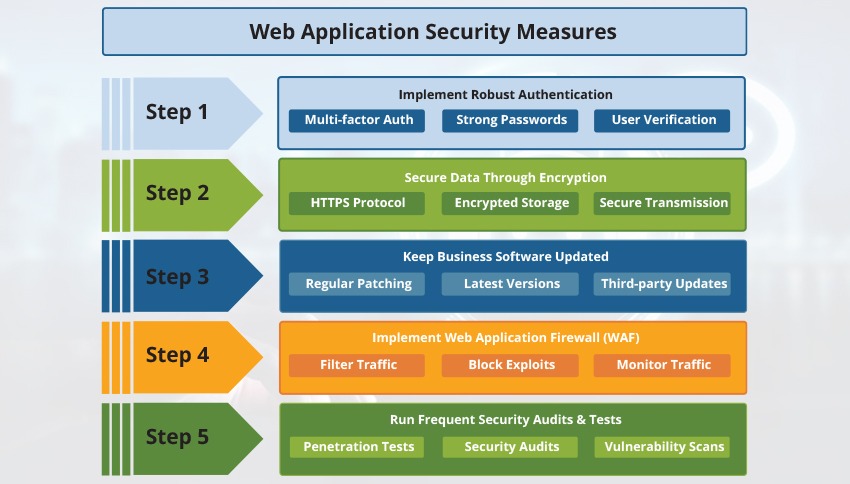- February 17, 2025

In the era of digital threats to businesses, web application security has become a necessity. Studies show that web application attacks are involved in over 26% of all breaches, and websites encounter an average of 90+ attacks daily. Weak security measures can have detrimental repercussions, making it essential to adopt best practices to protect your business and reputation. Lets explore the importance of web app security and how it can save businesses millions of dollars.
Table of Contents
Why is Web App Security Important?
With the digitization of businesses and the rise of online transactions, the need for securing web applications has become more pressing than ever. Cybercriminals are becoming increasingly sophisticated, rapidly exploiting vulnerabilities, and making no web application immune to potential attacks. Web applications are becoming more sophisticated and interconnected, and they also expand the attack surface for potential hackers.
In addition to mitigating risks, robust web application security has become vital in fostering trust in the digital marketplace. Customers today are more informed and vigilant, often equating their online safety with the security measures of the business. A single breach can damage the reputation of the company irreparably, leading to the loss of revenue, trust and customers.
Demonstrating a strong commitment to security can enhance a brand’s reputation, boost customer loyalty, and ultimately drive business growth. Web app security best practices will not only prevent financial losses but, will safeguard customer information, uphold business integrity and create a secure digital environment where customers can feel safe to transact.
How Can Businesses Strengthen the Web Application Security
Here are some steps that can help companies strengthen web application security.
1. Implement Robust Authentication Mechanisms
The initial defense for any web application is a robust authentication system. A weak or improperly implemented web app security measure can expose the application to unauthorized access. As a best practice, businesses should consider implementing multifactor authentication (MFA). MFA requires users to provide two or more verification factors to gain access, making it difficult for attackers to compromise accounts. Additionally, password policies should be stringent. Businesses should encourage and enforce the use of complex and unique passwords and implement regular password changes.

2. Secure the Data Through Encryption
Data encryption is one of the most effective ways to safeguard sensitive information. Encryption will help to convert the readable data into a completely coded form, making it unreadable for anyone, without the use of any decryption key. This ensures that when the data is stolen or intercepted, then it gets useless to the cybercriminals. HTTPS will ensure that encrypted data gets transmitted between the web server and the user’s browser, keeping them safe from man-in-the-middle attacks and data tampering. Encryption should extend to all sensitive data, which includes personal information, log-in credentials and transaction data.
3. Keep the Business Software Updated
Ensuring software is up to date is critical in maintaining web application security. Software updates deliver new features and patch the vulnerabilities that the hackers could exploit. Underlying libraries and platforms also require attention. Making use of third-party components can expose web applications to security risks. Implementing routine updates is an exceptional web app security best practice, and a patch management process will help reduce the potential for exploitation.
4. Implement a Web Application Firewall
A web application firewall (WAF) is an extra layer of additional security that protects the web application from common exploits and vulnerabilities. WAFs filter, monitor, and block malicious web traffic targeting a web application. Web application firewalls will work by filtering, monitoring and blocking the malicious web traffic that travels towards a web application. They help defend against many threats such as cross-site scripting, SQL injection and other security threats.
5. Run Frequent Security Audits and Penetration Tests
Verifying the effectiveness of security measures can be achieved through regular security audits and penetration tests. Security audits examine web applications for compliance with security policies, user access controls and configurations. Penetration tests on the other hand, help locate potential security vulnerabilities that hackers could exploit.
Web application security is indeed a necessity in today’s digital landscape. In the realm of cybersecurity, proactive measures and vigilance can be the best allies in safeguarding the web application and in maintaining the trust of digital customers. Businesses should have a well-defined blueprint to secure sensitive web applications. This involves prioritizing more high-risk applications which can be easier to identify if businesses have an inventory or repository for all the web applications that the business uses or provides to its end users.
Step-by-Step Implementation of Web Application Security
Conducting a web app security audit is a crucial process that identifies the risks and strengthens the defenses. The step-by-step process of performing the audit is as follows.
1. Listing all the Web Assets
Businesses should create a comprehensive list of all assets that are connected to the application, including the databases, APIs and third-party tools. This will help in identifying potential weak points. During this audit, companies should also locate and disconnect any APIs that are outdate and no longer in use but are still connected to their app. These outdated APIs can serve as entry points for hackers.
2. Evaluating the Existing Security Setup
Businesses should take time to evaluate their existing security setup and evaluate their firewalls, encryption status, authentication measures etc. They should also evaluate if the business protection is configured property and if the passwords are kept secure.
3. Identify the Risks and Threats
Conduct a risk assessment to pinpoint vulnerable components of the app, such as payment systems and sensitive customer data. Evaluate the types of data the app handles and develop a specific threat model to defend against potential threats.
4. Identify the Vulnerabilities
Utilize the diverse automated tools available, such as vulnerability scanners, and perform manual code reviews to detect insecure coding practices. These methods can uncover vulnerabilities that may have been overlooked, even by outdated software.
5. Reporting and Acting on the Findings
Create a detailed report outlining the vulnerabilities and recommend remediation steps. This should accompany a timeline for addressing each issue. This report will serve as a guide for the team to patch security gaps.
How Web App Security Helps Businesses to Save Millions
Web app security is critical for businesses as it helps prevent cyberattacks, operational disruptions, and data breaches that could result in significant financial losses. Here’s how businesses can save millions by adopting robust web app security.
1. Web App Security Helps Prevent Data Breaches
Data breaches can expose sensitive customer and business information, leading to lawsuits, loss of trust and regulatory fines. Strong security measures can help prevent data breaches and save businesses millions of dollars.
2. Projects Against Downtime
Cyberattacks, such as Distributed Denial of Service (DDoS) attacks, can make web applications unavailable to customers, damaging the business’s reputation. Web security tools prevent downtime, saving businesses from losses in productivity and financial setbacks.
3. Safeguards the Intellectual Property of the Business
Unauthorized access to proprietary business data can result in financial losses and disrupt its competitive advantage. Web app security best practices help prevent the theft of intellectual property, preserving innovation and securing market position.
4. Reduces Legal and Compliance Costs
Non-compliance with standards such as PCI DSS, HIPAA, and others, can lead to hefty fines and legal bottles. Appropriate web app security ensures compliance, mitigating fines and legal expenses.
5. Protects Customer Trust and Reputation
A data breach or hack can destroy customer trust, leading to revenue losses and customer churn. Investing in security preserves customer loyalty and brand reputation, thus preventing long-term financial damage.
6. Reduces the Cost of Remediation and Recovery
Cleaning up after a cyberattack is costly. Thus, businesses should pay for IT remediations, lost revenue and PR damage control. Proactive web app security will mitigate the need for expensive recovery.
7. Prevents Financial Fraud
Web vulnerabilities can be easily exploited, exposing the business to financial fraud, such as unauthorized transactions, theft of payment data. Implementing security like encryption and secure authentication helps prevent fraudulent activities, saving businesses from direct financial losses.
TestWheel offers a robust set of web app security tool to help safeguard web applications, ensuring and enhancing comprehensive protection. Our solutions include diverse vulnerability assessments to identify the weak spots and perform penetration testing to simulate real-world attacks and API security measures to protect and enhance the data exchanges. We also render exceptional firewalls and offer continuous monitoring to keep the threats at bay and ensure ongoing security. With TestWheel’s expertise, businesses can strengthen their web applications, mitigate risks and build trust with customers.



